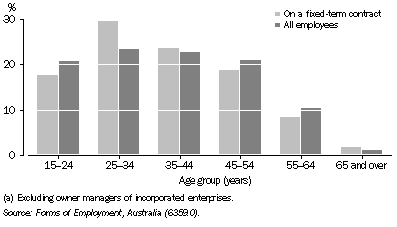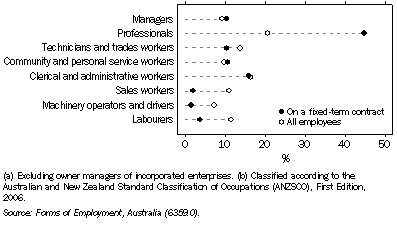FEATURE ARTICLE 1: FORMS OF EMPLOYMENT
Over the past few decades, there have been a number of significant changes in the Australian labour market. There has been increased participation of women and students, growth in service and knowledge jobs, and diversification in the employment arrangements available. Globalisation and changes in technology have also led to the demand for organisations to be more flexible and responsive. Differing forms of employment may assist organisations to better meet their business needs, and individuals to balance their work and non-work commitments. This article focuses on employees (excluding owner managers of incorporated enterprises) who worked on a fixed-term contract, using data from the 2006 Forms of Employment Survey, conducted by the Australian Bureau of Statistics (ABS).
Data on the forms of employment of Australians was collected in November 2006 as a supplement to the ABS monthly Labour Force Survey. The survey provides information on different types of employment arrangements which can be cross-classified by characteristics such as hours worked, industry, occupation and by demographic characteristics.
Employees who worked on a fixed-term contract
Fixed-term contracts are those that specify the employment will be terminated on a particular date or event. For the purposes of this article, employees who worked on a fixed-term contract excludes owner managers of incorporated enterprises. In November 2006, employees who worked on a fixed-term contract comprised 378,800 or 5% of all employees. Women represented a greater proportion of fixed-term employees (56%) than all employees (48%). In comparison, in November 2004 there were 284,400 employees working on a fixed-term contract, representing 4% of all employees.
Almost a third (30%) of the employees who worked on a fixed-term contract in November 2006 were aged 25-34 years (graph 8.23). In comparison, less than a quarter (24%) of all employees were in this age group. The highest proportions of both men and women working on a fixed-term contract were also in this age group (28% and 31% respectively).
8.23 Employees(a), by age group

Fixed-term contracts are more common among professionals and workers with higher levels of education. Almost half (45%) of the employees who worked on a fixed-term contract in November 2006 were Professionals (graph 8.24). This was more than twice the proportion (21%) of all employees in this occupation group. Of Professionals who worked on a fixed-term contract, almost three-fifths (57%) were women. Education professionals comprised more than a third (36%) of the Professional employees who worked on a fixed-term contract, but they represented just a quarter (25%) of all Professional employees. Almost half (47%) of female fixed-term employees who worked as Professionals were Education professionals. In comparison, Educational professionals represent just under a third (31%) of all female Professional employees. About 17% of male fixed-term employees working as Professionals were employed as Health professionals. This was more than double the proportion of all male employees in that occupation group (8%).
8.24 Employees(a), by occupation(b)

In some industries, the use of contract workers may enable an organisation to import needed skills rather than having to 'grow' the skills in-house. Other reasons for utilising contract workers include the ability to respond better to changes in demand for labour and to reduce costs. Fixed-term employment predominantly occurs in just a few industries, including Education and training, and Public administration and safety. It is more heavily used in the public sector than the private sector.
Almost a third (31%) of fixed-term employees in November 2006 were employed in Education and training (graph 8.25). This was more than three times the proportion (9%) of all employees in the same industry group. Of the fixed-term employees in this industry, more than three-fifths (63%) were employed in Professional occupations. Almost twice the proportion of fixed-term employees worked in the Public administration and safety industry, compared with all employees in the same industry group (13% and 7% respectively). In this industry, more than a third (35%) of the fixed-term employees were Clerical and administrative workers. The Manufacturing and Retail trade industries both had small proportions of fixed-term employees (3% and 2% respectively), in comparison to all employees in the same industry groups (11% and 12% respectively). Almost a third (31%) of fixed-term employees in the Manufacturing industry were Technicians or trades workers and just under half (47%) of the fixed-term employees in Retail trade were Sales workers.
8.25 Employees(a) who worked on a fixed-term contract, by selected industries(b)

Although by its nature, fixed-term employment is supposed to be 'fixed-term', often it is possible for a new employment contract to be entered into by the same employee and employer. In November 2006, three-quarters (75%) of employees working on a fixed-term contract expected their contract to be renewed, compared with less than three-quarters (71%) in November 2004.
References
Owen C & Bound H, 1999, Strategic alliances and the new world of work, Research Paper, University of Tasmania, Hobart
Productivity Commission, May 2006, The role of non-traditional work in the Australian labour market, Commission Research Paper, Melbourne
Watson I, Buchanan J, Campbell I & Briggs C, 2003, Fragmented futures: New challenges in working life, The Federation Press, Sydney
 Print Page
Print Page